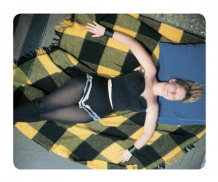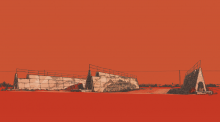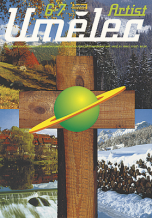| Revista Umělec 1999/4 >> The American Century? The Whitney’s Misleading Millennium Project | Lista de todas las ediciones | ||||||||||||
|
|||||||||||||
The American Century? The Whitney’s Misleading Millennium ProjectRevista Umělec 1999/401.04.1999 Františka a Tim Gilman-Ševčík | exhibition | en cs |
|||||||||||||
|
"The Whitney Museum of American Art in New York has committed the entire space of the museum for nine months to a two-part exhibition entitled The American Century. The title can be understood in two ways - as they imply throughout the exhibition, that the twentieth century was dominated by and therefore belonged to America, or more accurately, that this is the twentieth century as seen through the eyes of America. Granted, America as an idea and reality grew to stupendous proportions throughout the course of the last hundred years, but to characterize the entire century as being dominated by the U.S. would be an act of arrogance and egotism of which perhaps only this nation is capable. (Not too long ago the Brits would have attempted the same thing.) The sad fact is that this kind of hegemonic tunnel vision should have disappeared with modernism, and that this show fails to acknowledge the forces of influence from outside of the central narrative of American art that painted the face of American culture throughout the century.
At the beginning of the century, America was firmly entrenched in backward-looking provincialism. The top floor of the museum shows how certain individuals, Paul Strand and Alfred Stieglitz, for example, began to cut individual paths away from the norm that connected them to European tendencies. The fact that the photography, as well as film-making here and throughout the exhibition, is consistently the strongest and most progressive work is significant. When freed from traditional media, the Americans seem more able to explore art progressively and shed the romantic longings for European sensibilities that is seen in much of the painting and sculpture. In order not to distract from the central focus of the exhibition, that American culture was dominant and self-defining, no biographical information about the artists is listed on the title cards. Even Duchamp’s famed urinal Fountain is shown among the other “American“ pieces of the time, though it was made in France before Duchamp had ever visited the U.S. Certainly Fountain had an incalcualable influence on American art, but here it is shown among photographs and paintings of industrial objects that show enthusiasm for the beauty and power of the machine age, rather than the ironic criticism that Duchamp felt. The expressed aim of the exhibition is to show American culture - art, decorative arts, architecture, literature, dance, film, and music. Some very beautiful examples of design and architecture - Frank Lloyd Wright’s Falling Water, the Eames chairs, are shown, and the music and film are used as historic wallpaper throughout; dance, theater and literature particularly, are neglected, if not forgotten. The scope is at once too broad and too narrow. Had they limited their goal to displaying just visual arts, they would not have done such a disservice to literature and theater. The number of objects - 600 in this half covering 1900-1950, and another 600 in the second half covering 1951-2000 which begins September 26th, are not sufficient in number to capture the entire cultural output of the country in its period of rapid expansion. The skeleton of culture presented actually functions as more of a historical document - that which you would find in an outdated historical textbook. The art is not art here, in most cases, but artifact. The difference being that it seems impossible to draw inspiration or new insight from the objects in this configuration. They are lined up to reassure, not re-evaluate. The presence of politics and propaganda throughout the first fifty years of the century is very striking in a historical context. The population is pulled together behind points of pride indicating American greatness such as iconic skyscrapers, factories, automobiles and industrial growth, as well as the idealizations of American life embodied by Hollywood stars and American families. America as a philosophical ideal was perhaps more effective than socialism in building and maintaining a propaganda machine internally which kept all eyes on one shining point - the American Dream. Politically, the social conscience was constantly being pricked by the critical eye of its photographers like Margaret Bourke-White and Edward Weston, but never enough to produce the disillusionment with the system that occurred later on. The public funding of art is justified through its assumed ability to be instructive. Here, the art is more illustrative about the thinking and dominance of culture at the time it was produced rather than of how we can look at it now, or in other words, what we can learn from our past. The Whitney had the opportunity to enlighten the American people about the evolution of art that is still popularly unaccepted - to bring to light minority trends, art beyond the popular scope, that which was covertly influential, to challenge the master narrative of modernism with postmodern hindsight. The nationalist theme and tendency are outdated, and in America, fundamentally untrue. American culture has evolved as a free-form symphony with open doors - players walk in from all sides to contribute to the sound - like a massive jazz improv that is then heard by the rest of the world. But to refuse to give proper credit to the players and their origins, to give precedence to the concert hall, is not merely short-sighted, but inaccurate and misleading. The only minority artists acknowledged come from the Harlem Renaissance, a movement which was quickly accepted in New York as an exotic alternative to European culture and enjoyed short-lived tolerance that did little to give African Americans a voice in the future of the cultural mainstream as is seen in their lack of presence in the rest of the exhibition. The absence of subversive, outsider influences, those that did not succeed popularly is missed - the continuance of history depicted as a victor’s parade is painful and frustrating. The title of the show comes from an editorial written in Life magazine in February 1941, meant to encourage the American people to stand behind the country’s entrance into World War Two. It was a call for a re-positioning of America as outward-looking, rather than focusing on itself alone. The cry was not popularly taken up until America itself was bombed at Pearl Harbor in December of 1941, but this outward turn in politics and power coincided, it seems, with the change in American art culture’s power. While American film and music had enjoyed popularity and influence abroad for many years, it took the War to give America what it needed to get ahead in art - the talent and the confidence. The talent came from Europe - it was forced out by the persecution of the Nazis. The confidence came easily to Americans - they had been cultivating their egos for two hundred years in their dominance of industrial growth and westward expansion, and their demonstrated strength in the war only encouraged them more. But with great strength also came disillusionment, social upheaval and re-evaluation on a scale that never surfaced before the U.S. had clawed its way to the top - though certainly the roots existed, they are not laid bare here. Perhaps in the second half of the exhibition the uncritical enthusiasm for the formation and legacy of America will be examined with a more critical and revealing eye, because we do not need to hear any more hollow public relations messages telling us how great America is. A parallel virtual exhibition can be seen at www.artmuseum.net. "
01.04.1999
Artículos recomendados
|
|||||||||||||
|
04.02.2020 10:17
Letošní 50. ročník Art Basel přilákal celkem 93 000 návštěvníků a sběratelů z 80 zemí světa. 290 prémiových galerií představilo umělecká díla od počátku 20. století až po současnost. Hlavní sektor přehlídky, tradičně v prvním patře výstavního prostoru, představil 232 předních galerií z celého světa nabízející umění nejvyšší kvality. Veletrh ukázal vzestupný trend prodeje prostřednictvím galerií jak soukromým sbírkám, tak i institucím. Kromě hlavního veletrhu stály za návštěvu i ty přidružené: Volta, Liste a Photo Basel, k tomu doprovodné programy a výstavy v místních institucích, které kvalitou daleko přesahují hranice města tj. Kunsthalle Basel, Kunstmuseum, Tinguely muzeum nebo Fondation Beyeler.
|



































 We Are Rising National Gallery For You! Go to Kyjov by Krásná Lípa no.37.
We Are Rising National Gallery For You! Go to Kyjov by Krásná Lípa no.37.
Comentarios
Actualmente no hay comentariosAgregar nuevo comentario